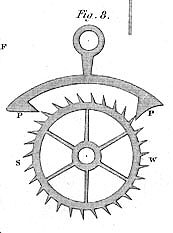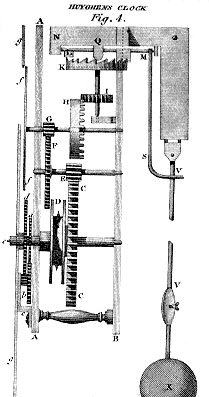The Pendulum
Today, we attend the wedding of science and technology. The University of Houston's College of Engineering presents this series about the machines that make our civilization run, and the people whose ingenuity created them.
The early 17th-century philosopher Francis Bacon started a very important change in people's thinking when he suggested that science should serve technology. In 1620 he wrote:
The empire of man over things is founded on the ... sciences ... for nature is only to be commanded by obeying her.
We accept that advice today; but in 1620 scientists and the people who built things lived in different worlds
The modern engineer came into existence only after the people who made things had joined forces with the people who studied physical principles. The first time in European history that this happened was just after Bacon told us that "nature is only to be commanded by obeying her." And it happened because people wanted to improve the accuracy of clocks.
A mechanical clock depends on a mechanism called an escapement that moves back and forth in a steady rhythm. In 1585 most escapements were masses on the ends of a rod that rhythmically swung back and forth. But in 1585 Galileo showed that the period of oscillation of a gently swinging pendulum was always the same -- regardless of the amplitude of its swing. The pendulum stood to make an ideal escapement device, because it always swings at the same speed, even while it runs down.
In 1641 Galileo's son Vincenzio built the first clock that used a pendulum escapement. The Dutch and English physicists Christian Huygens and Robert Hooke followed Vincenzio's work later in the 1600s with improved theories of the pendulum and better clock designs.
The pendulum escapement was the first technological innovation that resulted directly from the application of a scientific principle -- and it was actually carried out by the most important scientists of the day.
Since then, we've listened to Bacon's assertion that we must bend to nature -- understand nature -- if we're to control her. Today's engineers are trained to the teeth in science. Our aim is to make things, but we know we have to submit to nature before we try to command her.
I'm John Lienhard, at the University of Houston, where we're interested in the way inventive minds work.
(Theme music)
Usher, A.P., A History of Mechanical Inventions. Cambridge: Harvard University Press, 1970, Chapter XII.
Wolf, A., A History of Science, Technology, and Philosophy in the 16th and 17th Centuries. London: George Allen & Unwin, Ltd, 1950.
For more on Galileo and the pendulum, see the following website: http://es.rice.edu/ES/humsoc/Galileo/Things/pendulum.html.
For a substantially revised version of this episode, see Episode 1307.

(Drawing by John Lienhard)
A Pendulum Escapement Mechanism

(From the 1832 Edinburgh Encyclopaedia)
Detail of the "Anchor Escapement"

(From the 1832 Edinburgh Encyclopaedia)
Huygens's Pendulum Clock